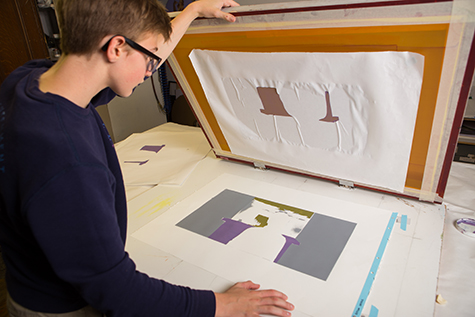The Crucial Overview to Comprehending Screen Printing and Its Versatile Utilizes
Screen printing has an abundant history that dates back to ancient times, advancing right into an innovative technique utilized across numerous sectors today. This overview explores the complexities of the screen printing procedure, detailing its applications in home, advertising and marketing, and style design - 10:9 Design reviews. Recognizing these principles can open imaginative potential for both artistic and commercial projects. The following sections will certainly expose necessary tips and techniques to boost one's screen printing ventures
The History of Screen Printing
Although screen printing has origins that map back centuries, its development reflects the artistic and technological improvements of various cultures. Stemming in ancient China, the technique was at first made use of for decorating textiles and later spread to Japan, where it became important to Ukiyo-e woodblock printing. The technique shifted to Europe in the 18th century, where it acquired popularity amongst craftsmens and industrial printers. The innovation of photo emulsion in the 20th century changed screen printing, permitting more detailed designs and greater efficiency. Musicians like Andy Warhol even more pushed its appeal, utilizing the tool to produce iconic works that blended commercialism and great art. By the late 20th century, screen printing had established itself as a flexible strategy, used in vogue, marketing, and great art. Today, it remains to develop, integrating electronic technology and broadening its applications throughout different markets.
The Screen Printing Refine Explained
Screen printing transforms creative visions into substantial styles through a series of precise steps. An image is created and after that transferred onto a screen, commonly made of fine mesh material extended over a framework. A light-sensitive solution is used to the screen, which is revealed to light, hardening in areas not covered by the image. After rinsing the unhardened solution, a pattern is created.
Next off, the screen is positioned over the substrate, whether it be material, paper, or another product. Ink is then pushed through the open areas of the pattern using a squeegee, depositing the design onto the substrate listed below. This procedure can be repeated for numerous colors, requiring separate screens for every hue. Lastly, the published thing is cured using warm to assure the ink sticks correctly, resulting in a long lasting, dynamic design on-line.
Kinds Of Screen Printing Techniques

Furthermore, specialized strategies, such as discharge screen printing, eliminate dye from the textile to develop softer prints, while foil screen printing applies metal foil to accomplish a glossy finish (10:9 Design Embroidery). Each method offers distinctive attributes, satisfying various innovative requirements and production ranges, ultimately broadening the possibilities within the screen printing domain
Applications of Screen Printing in Different Industries

Additionally, the signs and marketing fields make use of screen printing for producing captivating screens and banners. This method enables vibrant shades and intricate designs that catch attention. In electronic devices, screen printing is utilized for applying conductive inks to circuit boards, essential for part links. The home decoration industry welcomes screen printing to produce distinct styles on fabrics and wall art. In general, screen printing functions as an important tool throughout diverse areas, enhancing items with customized and visually enticing graphics.
Tips for Successful Screen Printing Projects
While taking on a screen printing job, mindful interest to information can significantly boost the final end result. Picking high-grade products is essential; this includes the screen, inks, and substratums. Making use of suitable mesh matters can influence ink deposition and detail resolution. Preparation is equally important; comprehensive cleansing of screens and correct exposure times assure website crisp prints.
Next, precise enrollment is vital for multi-color prints. Utilizing positioning tools can aid achieve precise layering. In addition, testing prints on scrap materials before manufacturing assists recognize potential issues without throwing away resources.

Often Asked Inquiries
What Materials Are Finest for Screen Printing on Material?
Cotton and polyester blends are optimal for screen printing on material because of their resilience and ink absorption. Furthermore, specialized fabrics like silk or canvas can create one-of-a-kind textures and surfaces, improving the general design top quality.
How Do I Tidy and Maintain Screen Printing Tools?
To maintain and clean screen printing devices, one should on a regular basis clean displays with suitable solvents, examine mops for wear, oil moving parts, and store all products in a dry, dust-free atmosphere to lengthen their life expectancy.
What Are the Environmental Effects of Screen Printing?
Screen printing can have substantial ecological influences, including chemical waste from solvents and inks, water use during cleansing procedures, and power intake. Environmentally friendly materials and sustainable practices are necessary for minimizing these unfavorable impacts.
Can Screen Printing Be Done in your home Properly?
Screen printing can be effectively done at home with the right materials and methods. Hobbyists can create quality prints, though success depends on their ability degree, tools, and understanding of the procedure included.
What Are the Expenses Connected With Starting a Display Printing Organization?

Beginning a screen printing company involves prices for devices, products, and workspace. First costs generally range from a few hundred to numerous thousand dollars, depending on the scale, top quality of equipment, and wanted production capacity.
Screen printing has a rich history that dates back to old times, evolving right into a sophisticated method used across numerous industries today. One more technique, rotating screen printing, employs round displays, assisting in continuous printing on material rolls, thereby improving efficiency for massive manufacturings. Furthermore, specialized methods, such as discharge screen printing, remove dye from the textile to produce softer prints, while aluminum foil screen printing applies metallic aluminum foil to accomplish a glossy finish. In the style market, screen printing is commonly made use of to produce vibrant styles on garments, enabling brand names to display their one-of-a-kind designs. Cotton and polyester blends are ideal for screen printing on textile due to their toughness and ink absorption.